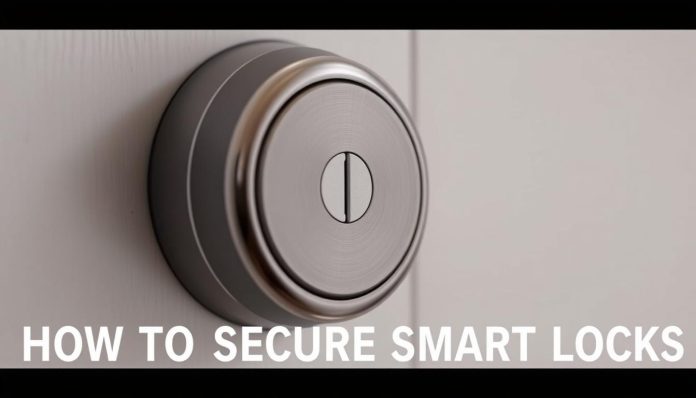You’ve bought a smart lock for its keyless entry and biometric authentication security. But, it’s important to know how to use and manage it right. This way, you get the most out of your smart lock.
Your home is now more secure than ever. It has features like remote locking and unlocking, voice control, and many ways to access it. You can use passwords, smartphone apps, or RFID cards. Knowing how your smart locking system works is crucial. It keeps your home safe from unwanted visitors.
Key Takeaways
- Understand the various access options available for your smart lock.
- Learn how to properly manage and maintain your locking system.
- Discover the benefits of advanced security features like biometric authentication.
- Maximize the convenience of keyless entry and remote locking.
- Enhance your home’s security with the right smart lock settings.
Understanding Smart Locks: An Overview
Smart locks have changed how we lock our homes. They offer cool features like keyless entry and biometric scans. It’s key to know about their types, what they can do, and why they’re good.
What are Smart Locks?
Smart locks are electronic locks that you can control from your phone or other devices. They’re a modern, secure way to lock your doors instead of old-fashioned keys.
Key features of smart locks include:
- Keyless entry
- Biometric authentication
- Remote access control
- Alerts and notifications
Types of Smart Locks
There are many types of smart locks to fit your needs. Here are some common ones:
| Type | Features | Benefits |
|---|---|---|
| Keypad Entry Locks | Numeric keypad for code entry | Convenient, keyless access |
| Biometric Locks | Fingerprint or facial recognition | Highly secure, unique identification |
| Smartphone App Locks | Control via smartphone app | Remote access, alerts, and notifications |
Advantages of Keyless Entry Systems
Keyless entry systems have many benefits. Here are a few:
- Convenience: No need to carry physical keys
- Enhanced Security: Less chance of lock tampering or key copying
- Remote Access: Can let guests or service providers in from afar
Knowing about the different smart locks and their features helps you choose the right one for your home.
The Importance of Securing Smart Locks
Securing your smart lock is key to keeping your home and family safe. Smart home tech brings ease with keyless entry and biometric locks. But, it also means you must ensure their safety.
Why Security Matters
Your smart lock is a main entry point to your home. If it’s not secure, it could let strangers in, risking your family’s safety. Also, a hack could harm other devices on your network.
Key reasons why security matters include:
- Protection against unauthorized access
- Safeguarding your personal data
- Preventing potential home invasions
Common Vulnerabilities
Knowing common vulnerabilities helps secure your smart lock. Some big issues are:
- Weak Passwords: Guessable passwords can let hackers in.
- Outdated Software: Not updating your lock’s software exposes it to attacks.
- Poor Network Security: An insecure home Wi-Fi network is a hacker’s doorway to your lock.
Knowing these risks lets you act to protect your smart lock. Use strong passwords, update your software, and keep your network safe.
Choosing the Right Smart Lock for Your Home
Choosing a smart lock for your home is crucial. It’s important to pick one that fits your needs and preferences. With so many options, knowing what makes each different is key.
Key Features to Look For
When picking a smart lock, look for certain features. Encryption and two-factor authentication boost security. Also, make sure it fits your door’s hardware to make installation easier.
- Check for compatibility with your door type
- Consider the level of security provided by the lock
- Evaluate the ease of use and user interface
Brand Recommendations
Many trusted brands offer top-notch smart locks. Schlage is known for its strong and dependable systems. Reading reviews and comparing brands can guide your choice.
Budget Considerations
Smart locks come at different prices, based on their features and brand. Setting a budget helps narrow your choices. Think about the long-term benefits, like saving on lock replacements.
By carefully looking at these points, you can find a smart lock that secures your home. It should also match your lifestyle and budget.
Setting Up Your Smart Lock Securely
To keep your home safe, setting up your smart lock right is key. A smart lock installed well boosts security and makes life easier with keyless entry.
Installation Best Practices
Always follow the maker’s guide when putting in your smart lock. Proper installation makes sure your lock works right and keeps your home safe.
- Make sure the lock is at the right height and is straight.
- Use the given templates or guides for the right spot.
- Check the lock several times after setting it up to make sure it works.
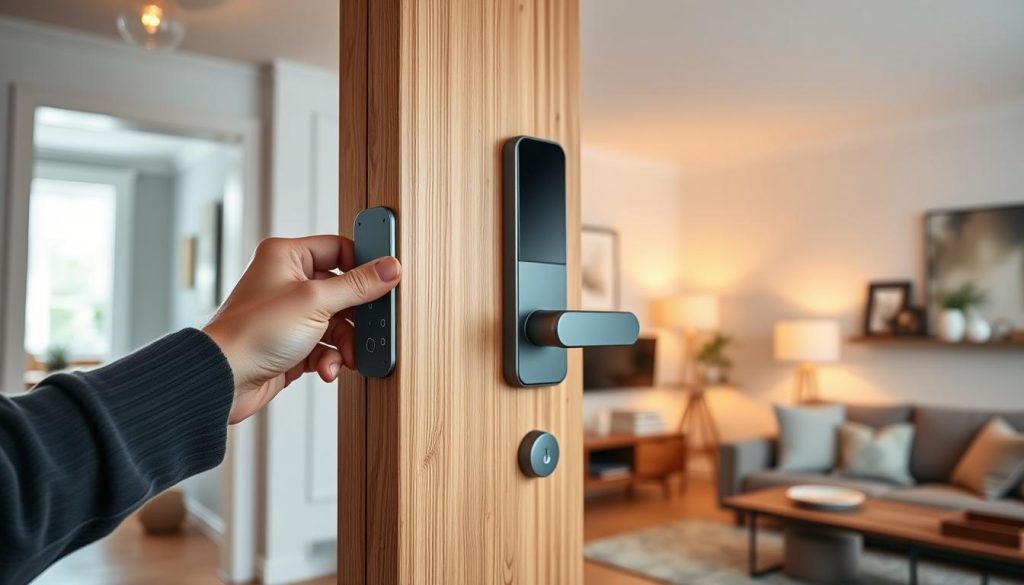
Changing Default Settings
Changing the default settings on your smart lock is a big step in keeping it secure. Default passwords and settings are easy for hackers to find. So, it’s important to make them your own.
Changing default settings means setting a strong password, setting up access levels, and turning on extra security like two-factor authentication if it’s there.
- Log in to your smart lock’s app or control panel.
- Go to the settings or configuration section.
- Change the default password to a strong, unique one.
Utilizing Strong Security Protocols
Securing your smart lock is more than just a strong password. It needs strong security protocols. To keep your home safe, you must go beyond the basics and use advanced security steps.
Two-Factor Authentication
One key way to make your smart lock safer is by using two-factor authentication (2FA). This adds an extra layer of security. It makes it much harder for anyone to get in without permission. Even if someone guesses your password, they still need a second step to get in.
Regular Software Updates
It’s important to keep your smart lock’s software current. Regular software updates fix new security holes. This keeps your lock safe from new threats. Always check for updates and install them right away to avoid security problems.
Using these strong security steps can greatly improve your smart lock’s safety. This protects your home and family from harm.
Password Management for Smart Locks
Creating and managing strong passwords is key for smart lock security. As you add a smart lock to your home, learning about password management is crucial.
Creating Strong Passwords
To keep your smart lock safe, you need a strong, unique password. Don’t use your name, birthdate, or common words. Instead, mix uppercase and lowercase letters, numbers, and special characters.
- Use a minimum of 12 characters.
- Incorporate a mix of letters, numbers, and special characters.
- Avoid sequential characters or repetitive patterns.
Example of a Strong Password: “G4$eJ#8dLpM2!”
Password Storage Solutions
After making a strong password, it’s important to store it safely. Use a trusted password manager to keep your login details. These tools can create complex passwords and store them securely.
| Password Manager | Key Features | Security Measures |
|---|---|---|
| LastPass | Password generation, autofill | End-to-end encryption, two-factor authentication |
| 1Password | Password generation, secure sharing | End-to-end encryption, two-factor authentication |
| Dashlane | Password generation, security alerts | End-to-end encryption, two-factor authentication |
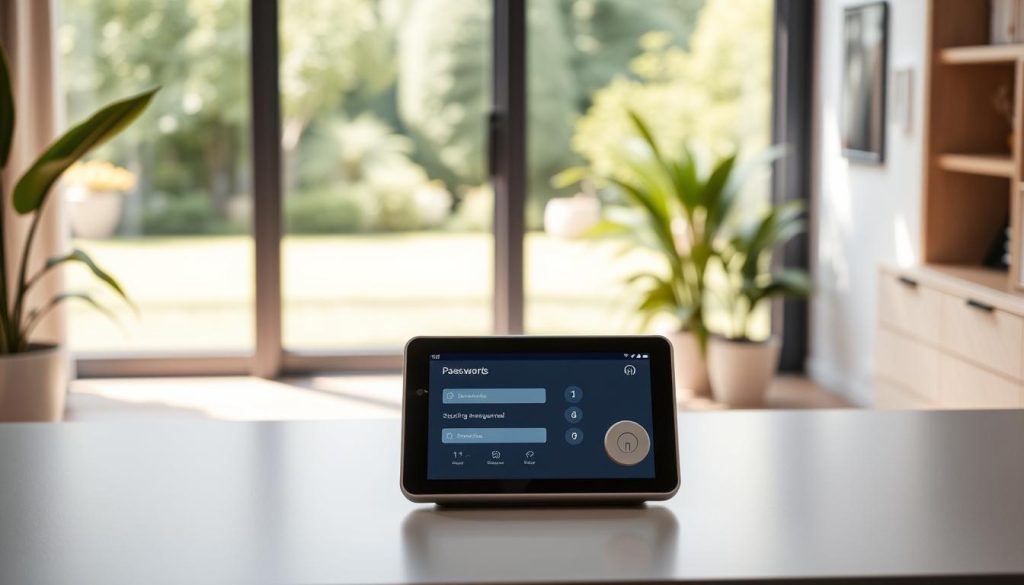
Biometric Locks: A Deep Dive
Biometric locks use unique physical traits for security. They are getting popular for home safety. They offer a secure and easy way to lock doors, unlike old systems.
Authentication Process
Biometric locks scan your biometric data, like fingerprints or faces. They compare it to what’s stored. Here’s how it works:
- Enrollment: Your biometric data is recorded and saved in the lock.
- Authentication: When you try to enter, your data is scanned and checked against the stored info.
- Verification: If it matches, you get in.
This makes sure only the right people can get in, boosting security a lot.
Advantages and Disadvantages
Biometric locks have big upsides, like high security and convenience. They ditch the need for passwords or keys, which many find appealing.
But, there are downsides too. They might cost more than regular locks. There’s also a chance of false negatives, where you’re not let in even if you should be. Plus, setting them up might need a pro, which adds to the bill.
Still, the good points of biometric locks make them a strong pick for better home security. Knowing how they work and their pros and cons helps you decide if they’re for you.
Securing Your Home Network
Protecting your smart lock and other smart devices starts with securing your home network. A secure home network is the backbone of your smart lock security. It prevents unauthorized access and potential breaches.
Importance of Wi-Fi Security
Wi-Fi security is crucial because it directly impacts the security of your smart lock and other connected devices. A vulnerable Wi-Fi network can be exploited by hackers. This can lead to unauthorized entry into your home.
Key aspects of Wi-Fi security include:
- Using strong Wi-Fi passwords
- Implementing WPA3 encryption
- Regularly updating your router’s firmware
Tips for Router Security
Securing your router is a critical step in protecting your home network. Here are some tips to enhance your router’s security:
- Change the default administrator password to a strong, unique password.
- Disable remote management to prevent external access.
- Enable the firewall to block malicious incoming traffic.
- Use a guest network for visitors to segregate them from your main network.
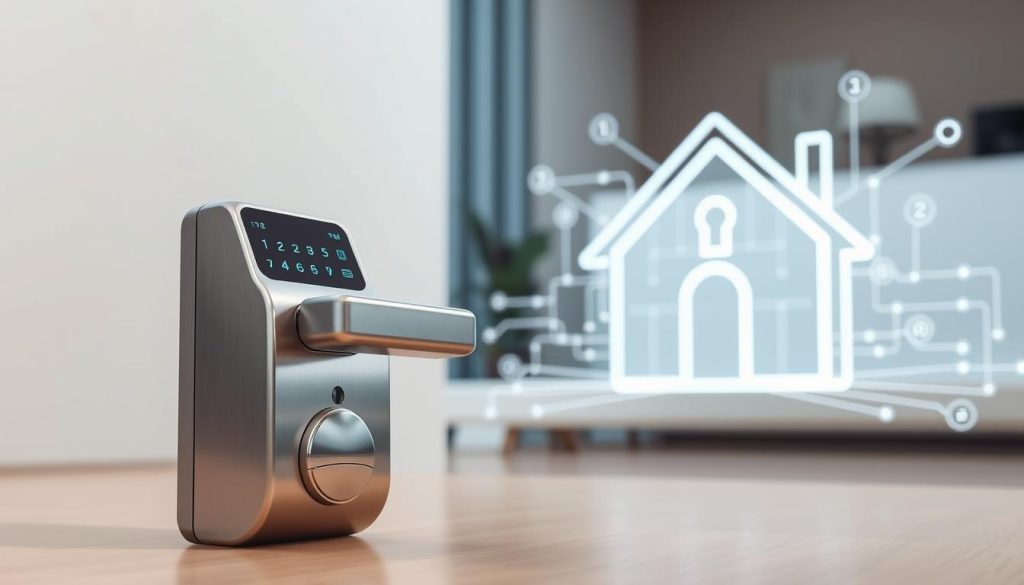
By following these tips and understanding the importance of Wi-Fi security, you can significantly enhance the security of your home network. This, in turn, improves the security of your smart lock.
Regular Maintenance and Monitoring
To keep your smart lock working well, regular maintenance is key. This means doing routine tasks to keep your lock safe and working right. It helps stop security problems and keeps your home safe.
Firmware Updates
Updating your smart lock’s firmware is very important. Firmware updates add security fixes and make your lock better. Always check for updates and install them right away. This keeps your lock safe and working as it should.
Best practices for updating firmware:
- Check for updates regularly
- Follow the manufacturer’s instructions for updating
- Ensure your lock is fully charged or connected to a power source during the update
Monitoring Access Logs
Keeping an eye on access logs is also crucial. Access logs show who has entered your home and when. By looking at these logs, you can spot any unauthorized access and stop it.
Regularly checking access logs helps spot security issues early. It’s smart to set up alerts for odd activity. This way, you’ll know about security problems right away.
Creating a Backup Plan
Creating a backup plan is crucial for your home’s security with a smart lock. Smart locks are great for security and convenience. But, they can fail or get compromised. A backup plan lets you always get into your home.
Traditional Keys vs. Smart Locks
When thinking about a backup, you might consider traditional keys. But, is it better to use keys or smart locks for security?
- Traditional Keys: Keys can be a good backup, but they can get lost or stolen.
- Smart Locks: Smart locks have features like keyless entry and biometrics, making them more secure.
Whether to use keys or smart locks depends on your security needs and what you prefer.
Emergency Access Solutions
Some smart locks also have emergency access options. These include an emergency code or a secondary key.
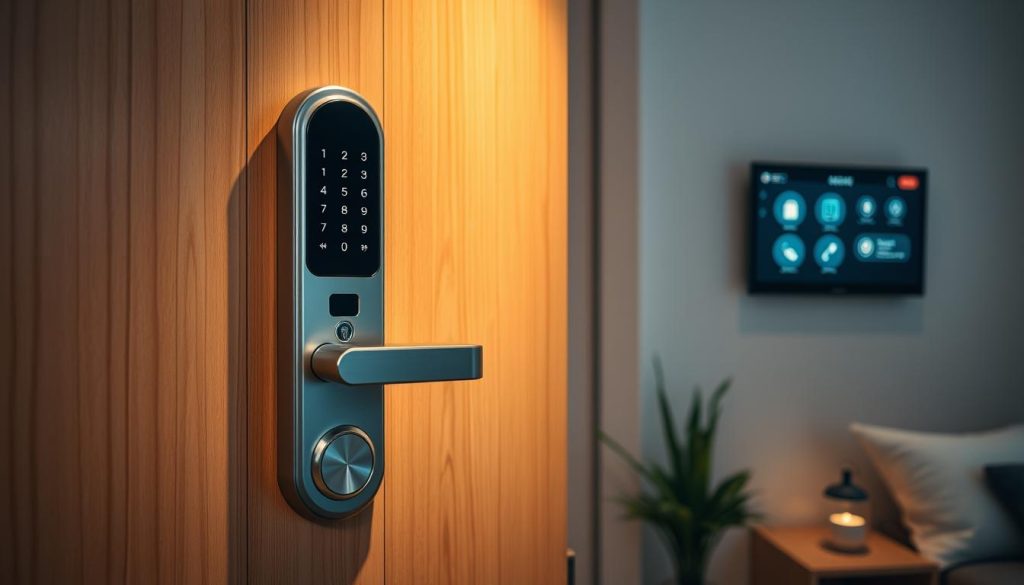
These options add more security and convenience. For example, an emergency code can be given to a trusted neighbor. This lets them enter your home in an emergency.
Key considerations for emergency access solutions include:
- Make sure the emergency access method is secure and hard to exploit.
- Keep the emergency code or key in a safe, easy-to-reach spot.
- Check and update your emergency access plans as your security needs change.
Educating Family Members
To keep your home safe, teach your family how to use smart locks. It’s not just about locking and unlocking. You also need to show them how to manage who can enter.
Training on Smart Lock Use
Start by showing how to use the smart lock. For biometric locks, teach them to add fingerprints or facial data. For keyless entry, explain how to enter a code or use the app.
Make sure they understand the need to keep the software up to date. Regular practice will make them feel more comfortable with the smart lock.
Setting Access Levels
Smart locks let you set different access levels for family members. You can give full access to your family and limited access to guests or service providers.
To set these levels, follow these steps:
- Identify the roles in your household (e.g., family, guests).
- Determine the access each role should have (e.g., full, limited, no access).
- Use the smart lock’s app or settings to set these levels.
This way, you can make your home more secure. You’ll know who has access and when.
Future Trends in Smart Lock Security
Technology keeps getting better, and smart lock security is no exception. You can look forward to new features that make your home safer. Expect to see better keyless entry systems and the use of artificial intelligence (AI) to improve security.
Advancements in Keyless Entry
Keyless entry systems are getting smarter, offering more convenience and safety. Soon, you’ll see advanced biometric authentication like better fingerprint and facial recognition. This will make it even harder for intruders to get in without permission.
The Impact of AI on Home Security
AI will be a big deal for smart lock security. It will bring predictive analytics and real-time monitoring. Your smart lock will learn your habits and spot potential threats, alerting you to act.
Keeping up with these trends will help you make better choices for your home’s security. It ensures you stay ahead of threats and know how to keep your smart locks secure.
